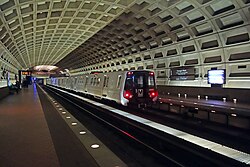Washington Metro
Washington, D.C. rapid transit system
(Redirected from Washington Metropolitan Area Transit Authority)
The Washington Metro is a rapid transit system that serves the Washington, D.C. metropolitan area in the United States. It has the second busiest rapid transit system in the United States.[2] The New York City Subway is the busiest.

Cleveland Park Metro station
(Red Line)
(Red Line)

Lines
changeThere are six lines in this system:
- Red Line, Opened 1976
- Blue Line, Opened 1977
- Orange Line, Opened 1978
- Yellow Line, Opened 1983
- Green Line, Opened 1991
- Silver Line, Opened 2014
History
changeThe first part of the metro system opened on March 27, 1976.[3] The rail system was completed on May 19th, 2023. [4]
References
change- ↑ 1.0 1.1 "WMATA Summary – Level Rail Car Performance For Design And Simulation" (PDF). Washington Metropolitan Area Transit Authority. October 13, 2013. Archived from the original (PDF) on February 9, 2014. Retrieved October 15, 2014.
- ↑ Christie Dawson (4 December 2008). "Heavy Rail Transit Ridership Report, Third Quarter 2008" (PDF). American Public Transportation Association. Archived from the original on 6 February 2009. Retrieved 23 September 2015.
{{cite web}}: CS1 maint: bot: original URL status unknown (link) - ↑ Douglas Feaver (25 October 1999). "Politics Couldn't Derail Metro, D.C.'s Engine of Change". The Washington Post. Retrieved 23 September 2015.
- ↑ "Washington, D.C. Metro System Fast Facts". Cable News Network (CNN). 27 July 2015. Retrieved 23 September 2015.
Wikimedia Commons has media related to Washington Metro.
Active railcars
change2000-series 3000-series 6000-series 7000-series
| KML file (edit • help)
|



